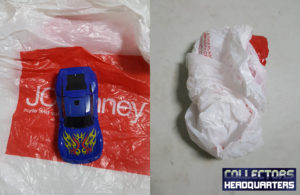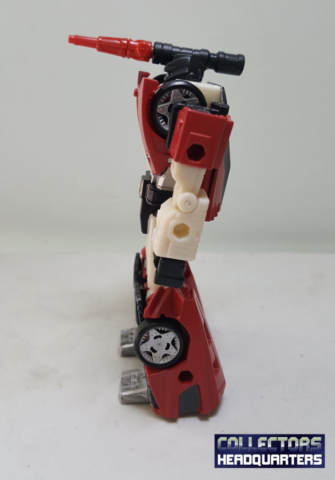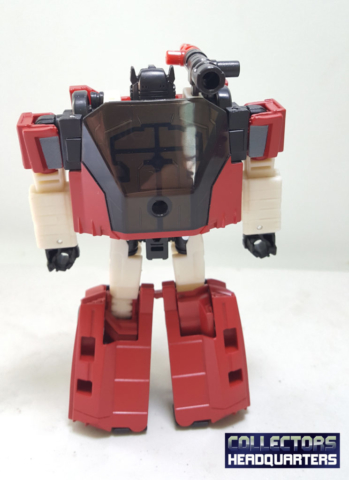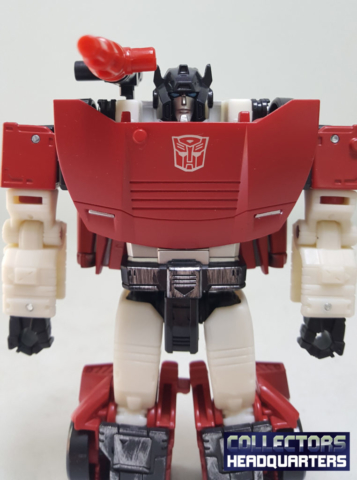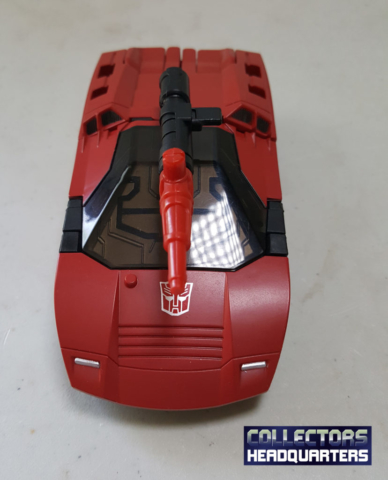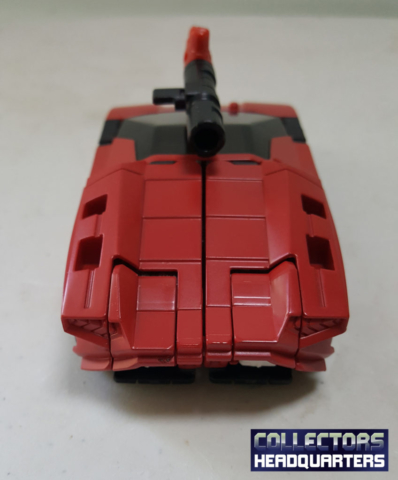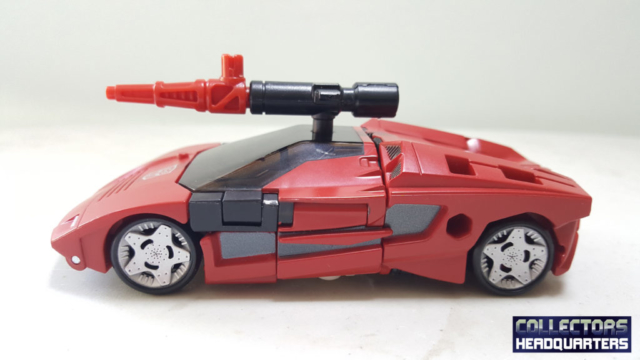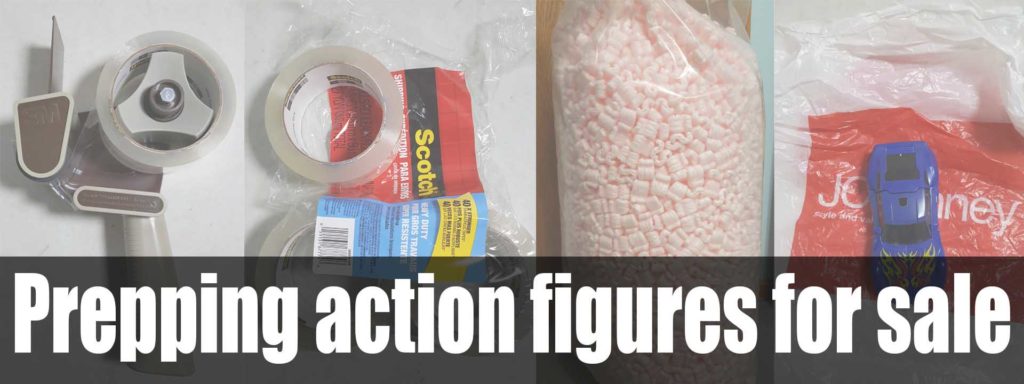
What you will need: a box, packing material, packaging tape, a tape gun, the figure(s) you are selling (Click here for a list of materials you may need)
Note: “Carded” means unopened action figures, and “Loose” means opened, or without original packaging. If you’re not an action figure enthusiast, you’re probably not familiar with these terms, so I thought it was important to define them.
Find a Box to Ship the Action Figure In:
Find a box that the action figure (loose or in its original packaging) fits in. Too small and you may end up damaging the action figure/figure packaging in the process of trying to cram it into the box. Remember its likely that the person you’re shipping this figure to is a collector who would like to keep the figure in its original packaging. They are not going to appreciate it if the figure’s box got bent when you were trying to force it to fit.
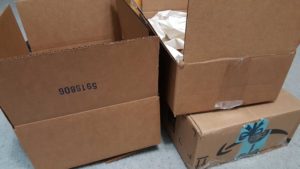 Boxes that are too large are also not ideal because you are going to end up using a lot of packing material to make up for the extra space. Especially if you don’t want the item bouncing around in there.
Boxes that are too large are also not ideal because you are going to end up using a lot of packing material to make up for the extra space. Especially if you don’t want the item bouncing around in there.
If you are only selling a few figures, you can, of course, reuse old boxes from around your house to ship the figures. Just remember to cover or tear off any previous labels. In the case that you’re doing allot of selling, purchasing boxes is probably ideal. I purchase most of my boxes from Uline; however, Amazon is also a very good option.
Under no circumstances are you to ship the action figure in a bubble mailer. To some it may seem fine to ship sealed action figures this way since they are already in packaging; however, if your buyer is a collector, they likely don’t want the action figure’s packaging getting damaged during shipping. Heck, if your buyer isn’t a collector, they’d still probably leave you negative feedback if you were to ship their item this way. Always use a box to ship figures.
What to Use as Packing Material When Shipping Action Figures:
Speaking of packing material, there are a number of different options our there. Plastic bags from Target, Wal-Mart, Giant Eagle, etc. are a good affordable option. If you sell figures infrequently, you might be fine not purchasing packing material at all and sticking with what you can find around your home: plastic
bags and packing paper will work. Also, if you make frequent online purchases, you can reuse some of the packing material from your Amazon or eBay orders.
If you intend to make selling a hobby or turn it into a serious source of side income you’re going to run out of material around your house pretty quickly, and you likely don’t buy enough at Target, Wal-Mart, or the grocery store to keep a large enough supply of plastic bags. In this case, its probably a good idea to order a bag of packing peanuts or air pillows.
Packing Loose Action Figures Vs Carded Action Figures:
There are some things you will do differently if you’re shipping a loose action figure vs one that is in its original packaging. For example, carded figures can be placed in a box and packed with packing peanuts without a second thought, but this probably isn’t ideal for shipping loose action figure
s. If the figure you are selling is loose, consider wrapping the figure in a plastic bag or bubble wrap before shipping it in a box full of packing peanuts. Its possible that your buyer could find himself/herself cleaning bits of peanuts out of the joints of the figure otherwise.
Also, if the packing material you’re using is dirty or dusty, the figure or figure packaging should be wrapped in a plastic bag to avoid the actual figure or figure packaging getting dirty. I would highly recommended wrapping your figure if you’re using newspaper as the packing material.
Packing Steps for Loose Action Figures (Carded Shown Below):
Okay, time to take you through the process I go through whenever I’m selling action figures:
Step 1: Verify that your figure has all its pieces (or all the pieces you can find):
Get any accessories the figure has together and make sure that nothing has been broken off or is missing. If you’re unsure about whether or not its missing anything, you can watch a review of the figure on YouTube, or go to message boards with your questions. The action figure Reddit would be a good place to start.
Step 2: Take Note of the Figure’s Condition:
Take note of loose joints, scratches and scrapes, color fading, broken parts, etc. Take all of this into account when grading your figure, and be sure to include anything of concern in the description. Some people grade their figures with a scale that is something like this.
Others will simply use terms like “Played with Condition” or “Used Only for display” do describe the item’s condition. For example a figure that has spent its life on a display shelf or in a cabinet is going to be “Used Only for Display” whereas one that you played with when you were a kid would be in “Played with Condition”. Obviously neither of these aptly describe loose joints or anything like that, so be sure to include information about that as well.
Depending on the value of the figure you’re selling, you will want to go into more detail about the figure’s condition. If the figure you’re selling is very expensive, or has significantly increased in value, then be very detailed about the figure’s condition.
Step 3: Get a Price For Your Action Figure:
This can be done by seeing what that figure is going for online. I recommend checking the sold listings on eBay to get an accurate idea of the figure’s worth. Keep the condition of the figure you’re selling in mind when looking at these listings. For example, if the figure has been opened and is incomplete, don’t list it at the same price as one that is new and in-box.
Step 4: Take GOOD Pictures:
I’m emphasizing “good” for a reason. Far too often do sellers take one—MAYBE two pictures before listing the item. Take more than this! I have paid more for a figure in the past simply because the seller took enough pictures for me to get an very good idea of its condition.
There is no set number of pictures to take; because every action figure is different. Some are going to require more pictures than others. Usually I take pictures of the front, back, side, and then some close ups of the upper half of the figure. I’ve included some examples of the types of pictures you might want to take.
Step 5: Package The Action Figures:
Use an appropriately sized box, so that the figure is not touching the sides. Make sure to use enough packing material so that the figure sits snugly in the box and does not bounce around when it is shook. If you use packing peanuts or your packing material is musty, wrap the figure in a plastic bag or bubble wrap. Tape well so that the box is sealed.
Step 6: List It:
List the item.
Packaging Carded Action Figures:
Step 1: Check the Condition of the Box and Figure Within:
In general, if you’re selling carded figures, the grading process is a little easier simply because you should have a pretty good idea of the figure’s condition. Look at the box, and take note of any damages, aging, and/or general wear and tear. Also check to see if the figure inside has had its color’s fade at all. Again, the more valuable the figure you are selling is, the more thorough you should be with the grading process. Here is good resource for grading the action figure packaging.
Step 2: Get A Price:
Apply the same principles as with pricing loose action figures. For highly valuable items, the condition of the packaging will have an effect on the selling price. Generally, for figures that have not seen their price rise significantly, the condition of the box will have less of an impact on the selling price.
Step 3: Take Pictures:
For the most part, you will not need to take as many pictures as you would selling a loose figure. Still, I recommend getting pictures of the front, back, and sides of packaging, along with any wear and tear.
Step 4: Package the Action Figure:
As mentioned in the beginning of this post, you don’t want the box to be too large or too small. Personally, I would say that at least an inch of space on all sides is probably good size for a box. Place enough packing material inside with the carded figure so that it acts as a cushion in the case that the package gets knocked around. Finally, tape the box shut.
Step 5: List the Item:
You’re done. You can list your item on eBay, Facebook, Amazon, or wherever you prefer to sell you figures.
Conclusion:
The most important thing to remember when selling action figures (loose or in their packaging) is to grade them properly and ship them with care. Packages can be shaken and/or damaged during transit. Take measures to ensure that doesn’t happen. Whether your buyer is a collector or not, the condition of the figure is important to them, and going the extra mile to accurately describe the figure’s condition, and preserve it during shipment will be appreciated, believe me.
If you want to read about where I recommend selling your figures, click here.
Related Articles
Are Action Figures a Good Investment?
Answer: They could be, but it depends on a number of factors: the specific action figures, the demand for those figures, the popularity of the franchise, and you—yes, you—the person doing the collecting. Are you considering starting an action figure collection as an...
Do Action Figures Increase in Value?
Answer: Whether or not a specific action figure increases in value is largely dependent upon the figure. Some figures will show significant increase in value over time, while other will see little to no increase. Regardless, if you want your figures to increase in or...
Where Should I Sell My Action Figures?
Answer: In general, eBay and Facebook are the best places to sell your action figures and collectables. So, whether you’re a collector who has never opened any of their figures, or you have a tub full of old toys you played with when you were a kid, you’re likely...

